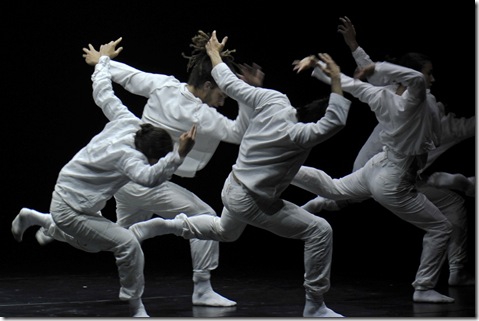Hofesh Shechter’s Barbarians. An Immense range of styles that has “no meaning”?
Photo: Gabriele Zuca
It appears that this autumn, London’s Royal Opera House season begins with Gluck’s Orphée et Eurydice directed by Hofesh Shechter . It is the choreographer’s directorial debut which can only make one imagine the most glorious of visual moments in the performance. Hofesh will also be doing the choreography of a Broadway revival of Fidler on the Roof, premiering in December. All these events emphasize the enormous versatility of this choreographer, whose trilogy Barbarians opened last night at the NAC. None of this news is surprising because this choreographer took us through an immense range of musics, rhythms, performance styles and relationships with the audience that are rarely seen during a single evening of any dance company.
Punctuating his work is a smooth dialogue between a female sounding computerized voice and the voice of the choreographer, bringing his creation into the realm of dance-theatre, we are told not to seek meaning, and there isn’t any, which of course is the best incentive to try to find that illusive meaning. We also hear that the choreographer doesn’t really know what he is doing but he is seeking something thrilling. And as well, we are one together, unique but one all fused together in each other’s being…”you are me”, some sort of intersubjectivity that becomes physically real in the dance as the bodies create something that fuses the group into one living creature, composed of parts that break away and are still able to express themselves as duos and trios within the landscape of the group…Hegel is not far off…but neither is contemporary rock, as the rhythms take hold of the dancers and send them off on hip hop movements, inviting the audience to clap with them and then suddenly, it all shifts, as other urban language appear. It all quickly turns into raw, rampant arm flailing, jumping, exploding with enormous energy and brief moments that seem to be ultra-violent encounters, a cross between rage and passionate love, while earlier, robots were set into action by the strong flashes of light (lighting played an important role as well.) There were changes in costume that opened new relationships with the body. From Japanese martial arts to ultra-sexy tightfitting skin toned body tights that glistened in the light and emphasized the individual forms. The costumes created another language.
There were balletic steps, reworked , torn apart by the electronic shocks but that retained enough of the original form to be recognizable, catching the sense of the baroque music remix that had the dancers slip into minuets and other traditional movements , heightened by the contemporary vibrating of the electronic sounds. There were moments that suggested prayers at the wailing wall, and Arabic belly dancing…cultures clashing and harmonizing then suddenly disrupted as the lights go out and dancers reappear nude, divested of any cultural reference at all. One’s need for “meaning” was in fact constantly being attracted and repelled and then it all comes together in the final image.
The loud electronic vibration enhanced by glaring spots became, after 1hour and 45minutes, almost physically difficult to take. Young people who attend raves, dance parties and places where that kind of loud vibrating is normal, would have no problem with this but I did come out of the theatre with a slight headache. There is no doubt that contemporary bodies that make up an audience have to adjust to contemporary sounds. I wonder if that means human beings are physically evolving to be able to absorb new external onslaughts on the senses? That might be the sort of relationship worth exploring !!
Go see The Barbarians if you can still get a ticket! It’s on again tonight.
Hofesh Shechter Company presents Barbarians.
Lighting Lawrie McLennan
Costumes Amanda Barrow
Johathan Beattie Sound Engineer.
